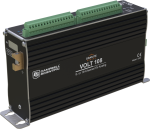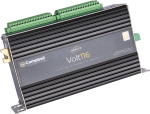This product is not available for new orders.

| Services Available | |
|---|---|
| Repair | Yes |
| Calibration | Yes |
| Free Support | Yes |
Overview
El CR3000 MicroLogger® es un sistema autónomo, registrador de datos robusto que puede medir la mayoría de los tipos del sensor directamente, se puede comunicar a través de módems, control de dispositivos externos, y almacenar datos y programas en cualquiera de memoria Flash no volátil respaldada por batería o SRAM.
La CR3000 tiene integrado, una pantalla de 8 líneas alfanuméricas y el suministro de energía. Una batería de respaldo, reloj en tiempo real y 4MB de almacenamiento no volátil de datos está incluido. El CR3000 está disponible con base en el sellado de la batería recargable, una base alcalina, o en una versión de bajo perfil, sin pilas.
Benefits and Features
- Ideal applications include eddy covariance, wind profiling, HVAC, weather stations, vehicle testing, air quality, process control, mesonet systems, agriculture, soil moisture, time-domain reflectometry, water quality
- Integrated keyboard and display screen let you program, manually initiate data transfers, and view data, all on site.
- Includes a current excitation channel allowing direct connection of PRTs or other sensors that use a current excitation
- Serial communications with serial sensors and devices supported via I/O port pairs
- Supports PakBus, Modbus, SDI-12, and DNP3 protocols
- Communicates via various options: TCP/IP, email, FTP, web server.
- Gas Discharge Tube (GDT) protected inputs
- Flexible power and communication options make it ideal for remote locations.
- Compatible with channel expansion peripherals allowing you to expand your system
- Battery-backed clock that ensures accurate time is maintained while data logger is disconnected from battery power
- Contains custom ASIC chip that expands pulse count, control port, and serial communications capabilities
- Program with LoggerNet, PC400, or Short Cut to fit your setup
- Collects and stores data and controls peripherals as the brain of your system
Images









3D/CAD Files:
Detailed Description
Housed in a portable, self-contained package, the CR3000 Micrologger consists of measurement and control electronics, communication ports, 16-character keyboard, display, power supply, and carrying handle. The integrated display shows 8 lines x 21 characters (64 x 128 pixels).
The CR3000 has a choice of three power-supply base options (alkaline, rechargeable, or no battery). Low power consumption allows the Micrologger to operate for extended time periods on its battery recharged with a solar panel—eliminating the need for AC power. It suspends execution when primary power drops below 9.6 V, reducing the possibility of inaccurate measurements.
The on-board operating system includes measurement, processing, and output instructions for programming the datalogger. The programming language, CRBasic, uses a BASIC-like syntax. Measurement instructions specific to bridge configurations, voltage outputs, thermocouples, and pulse/frequency signals are included. Processing instructions support algebraic, statistical, and transcendental functions for on-site processing. Output instructions process data over time and control external devices.
Compatibility
Please note: The following shows notable compatibility information. It is not a comprehensive list of all compatible products.
Software
| Product | Compatible | Note |
|---|---|---|
| LoggerNet | Version 3.2 or higher | |
| PC200W (retired) | ||
| PC400 | Version 1.3 or higher | |
| PCONNECT (retired) | Version 3.2 or higher | |
| PCONNECTCE (retired) | Version 2.1 or higher | |
| RTDAQ | Version 1.0 or higher | |
| Short Cut | ||
| VISUALWEATHER - Retired (retired) | Version 2.0 or higher |
Additional Compatibility Information
Sensors
With several channel types, the CR3000 is compatible with nearly every available sensor, including thermocouples, SDI-12 sensors, and 4 to 20 mA sensors. A custom ASIC chip expands its pulse count, control port, and serial communications capabilities. The CR3000's I/O ports can be paired as transmit and receive, allowing serial communications with serial sensors and devices.
Measurement & Control Peripherals
The CR3000 is compatible with all of our CDMs (requires an SC-CPI), SDMs, multiplexers, vibrating-wire interfaces, terminal input modules, and relays.
Communications
The CR3000 communicates with a PC via direct connect, Ethernet interfaces, multidrop modems, short-haul modems, phone modems (land line, digital cellular, and voice-synthesized), RF telemetry, and satellite transmitters (Argos, Iridium, and Inmarsat).
Data can be viewed on its onboard keyboard display, user-supplied iOS or Android device (requires LoggerLink), CD295 DataView II Display, or a user-supplied PDA (PConnect or PConnectCE software required).
Compatible external data storage devices are the CFM100, NL115, and SC115.
Enclosures
The CR3000 can be housed in an ENC12/14, ENC14/16, ENC16/18, ENC24/30, or ENC24/30S enclosure.
Power Supplies
The CR3000 is typically powered by its on-board alkaline or rechargeable power supply (see Ordering Info). When the rechargeable power supply is used, its internal 7 A h sealed rechargeable battery needs be charged via a vehicle (requires the DCDC18R), solar panel, or ac wall charger.
The CR3000 can also come with a low-profile base that requires a user-supplied dc source. It is preferred when the system’s power consumption needs a larger capacity battery or when it’s advantageous for the Micrologger to be thinner and lighter.
Software
CRBasic, the CR3000's full programming language, supports simple or complex programming and many on-board data reduction processes. Compatible software includes:
- Short Cut
- PC200W
- PC400 (version 1.3 or higher)
- LoggerNet (version 3.2 or higher)
- RTDAQ (version 1.0 or higher)
- PConnect (version 3.2 or higher)
- PConnectCE (version 2.1 or higher)
- VisualWeather (version 2.0 or higher)
Specifications
| -NOTE- | Note: Additional specifications are listed in the CR3000 Specifications Sheet. |
| Operating Temperature Range |
|
| Maximum Scan Rate | 100 Hz |
| Analog Inputs | 28 single-ended or 14 differential (individually configured) |
| Pulse Counters | 4 |
| Voltage Excitation Terminals | 4 (VX1 to VX4) |
| Communications Ports |
|
| Switched 12 Volt | 2 terminals |
| Digital I/O |
|
| Input Limits | ±5 Vdc |
| Analog Voltage Accuracy | ±(0.04% of reading + offset) at 0° to 40°C |
| ADC | 16-bit |
| Power Requirements | 10 to 16 Vdc |
| Real-Time Clock Accuracy | ±3 min. per year (Correction via GPS optional.) |
| Internet Protocols | FTP, HTTP, XML POP3, SMTP, Telnet, NTCIP, NTP, |
| Communication Protocols | PakBus, Modbus, DNP3, SDI-12, SDM |
| Idle Current Drain, Average | 2 mA (@ 12 Vdc) |
| Active Current Drain, Average |
|
| Dimensions |
|
| Weight |
|
Documents
Product Brochures
Manuals
Technical Papers
- Voltage Measurement Accuracy, Self-Calibration, and Ratiometric Measurements
- Preventing and Attacking Measurement Noise Problems
- Benefits of Input Reversal and Excitation Reversal for Voltage Measurements
- BACnet to Modbus Protocol Conversion (App. Note: 1M-C)
- Serial Sensors: Interfacing with CSI Dataloggers (App. Note Code: 2MI-V)
- CF Card Information (3SM-F)
Videos & Tutorials
Downloads
CR3000 OS v.32.07 (4.39 MB) 15-05-2024
Execution of this download installs the CR3000 Operating System and Compiler on your computer. It also updates the CR3000 support files for the CRBasic Editor.
Note: The Device Configuration Utility is used to upload the included operating system to the datalogger.
Upgrading from versions prior to version 28 of the Operating System will reset the datalogger’s CPU drive. This is due to a change in the format of the file system from FAT16 to FAT32. In order for the datalogger to operate correctly, as part of the upgrade, the CPU drive is formatted to FAT32. Any programs stored and running from the CPU drive will be lost. It is not recommended to update the datalogger’s Operating System over a remote connection where program control regulates the communication equipment (turning it on or off, etc.). In these cases, an on-site visit and a backup using DevConfig’s backup utility is necessary to update the datalogger’s Operating System.
Watch the Video Tutorial: Sending an OS to a Local Datalogger.
In all cases where the datalogger is being updated from an Operating System prior to 28, the use of DevConfig’s backup utility is recommended due to the CPU drive being formatted using the new FAT32 format.
Device Configuration Utility v.2.33 (49.6 MB) 07-07-2025
A software utility used to download operating systems and set up Campbell Scientific hardware. Also will update PakBus Graph and the Network Planner if they have been installed previously by another Campbell Scientific software package.
Supported Operating Systems:
Windows 11 or 10 (Both 32 and 64 bit)
Frequently Asked Questions
Number of FAQs related to CR3000: 6
Expand AllCollapse All
-
Look for a stamp on top of the battery. The stamp may be in a date format of YYMMDDXX where:
- YY is the year.
- MM is the month.
- DD is the day.
- XX is the manufacturing plant.
This indicates the age of the battery.
-
A practical maximum is to connect one multiplexer per every two control terminals on the data logger. Control terminals can be shared between multiplexers to increase the number of connected multiplexers. Sharing terminals, however, requires more complex wiring and programming. Users who would like to connect more than one multiplexer per every two control terminals are advised to contact a sales or support engineer at Campbell Scientific for assistance.
-
Sending a serial string out one of the data logger COM ports requires at least two instructions. Generally, the SerialOpen() instruction is used to set the characteristics of the communications port, such as baud rate and error detection (for example, 115.2k, N, 8, 1). The instructions SerialOut() or SerialOutBlock() can be used to transmit a specified string. See the CRBasic Editor Help for examples of programs using each of these instructions.
-
Yes. We have created a software application, Transformer, to help migrate CR23X program files to CR3000 program files. Transformer is available within LoggerNet 3.2 and higher.
- From the Windows Start Menu, navigate to LoggerNet3.0 | Utilities | Transformer.
- In LoggerNet 4.x, from the main LoggerNet window, navigate to Program | Transformer.
Transformer uses a .csi or .dld file created in Edlog to generate CRBasic code for a CR3000. A side-by-side comparison of the two programs is provided along with an action log that highlights parts of the program that may need attention or additional editing in CRBasic.
-
A free program generator for all Campbell Scientific data loggers is Short Cut for Windows (SCWin). Short Cut can be used to create programs in many situations where Campbell Scientific equipment is used.
In situations where program requirements are too complex or specialized for Short Cut, programs can be written in any text editor that can edit and save plain ASCII text. However, creating an error-free program would be very difficult. The CRBasic Editor that comes with PC400 and LoggerNet provides a programming environment with procedure templates, integrated help, programming examples, the ability to test compile the program before sending it, and many other features that can be very helpful when developing a program.
-
Yes. For example, the NL115 allows the CR1000 to communicate over a local network or a dedicated Internet connection via TCP/IP.
Casos de estudio
Overview The Department of Soil, Crop, and Climate Sciences at the University of the Free State......read more
Alfalfa is a thirsty crop. It uses more than 20 percent of all of the......read more
The Utah Department of Transportation is investigating the effect on the life span of bridges......read more
The Korean Meteorological Administration (KMA) is the governmental agency responsible for weather forecasting and managing......read more
Events in the Gulf of Mexico—hurricanes, oil spill, red-tide algae blooms—have shown the need for......read more











































